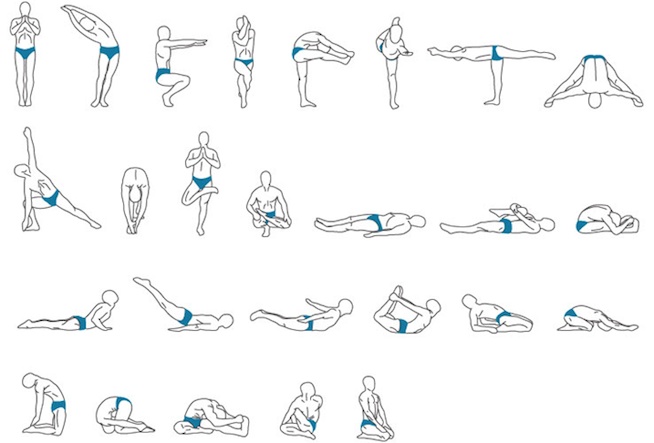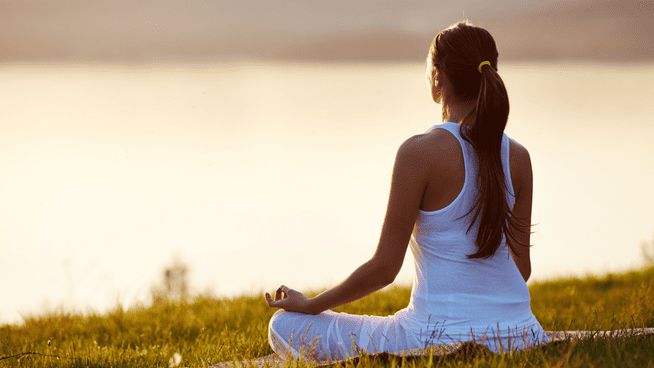Choudhury attempted to copyright the Bikram Yoga sequence from 2011, but was ultimately unsuccessful. In 2016, facing lawsuits and accusations of sexual assault, Choudhury fled to India, leaving Bikram Yoga, Inc. to be run by others
Bikram yoga may not be as safe as yogis believe, a new study suggests.
Yoga can be wonderful for your flexibility, balance and overall health. And recently, pro athletes such as Kobe Bryant, Andy Murray and Philadelphia Eagles quarterback Nick Foles have begun doing Bikram Yoga, an intense form of the practice in which the moves are performed in a hot, humid room.
“One of the hardest things I’ve ever done,” is how Foles described Bikram Yoga in an ESPN interview. But he also credited the practice with helping him recover more quickly from the hits he takes during the NFL season.
Named after its founder, Bikram Choudhury, and drawing from traditional yoga techniques, Bikram employs a series of 26 postures (see diagram below). The poses are always the same and always done in the same order in a room heated to approximately 105 degrees with 40 percent humidity. The classes last about 90 minutes. The general idea is that the heat increases blood flow and circulation to the muscles.

Photo: Bikram Yoga NYC
“By the end of a Bikram yoga class, you will have worked every muscle, tendon, joint, ligament, internal organ and gland while systematically moving fresh, oxygenated blood to 100 percent of the body,” says Bikram instructor Tori Hicks. “Bikram yoga builds strength, balance and flexibility by gently stretching and massaging the spine, muscles, tendons, joints and all internal organs of the body. Lung capacity is expanded, leading to greater vitality.”
In my first Bikram class, I was surprised by how many people were wearing minimal clothing—short spandex and sports bras, or even bathing suits. I was wearing pants, which I recognized as a terrible choice as soon as the sweat started streaming out of my body. Which happened quickly.
I had done a fair amount of yoga before, mostly Vinyasa style, which takes you through a sequence of moves between downward facing dog poses. Bikram class begins with a breathing exercise unlike anything I had ever done before. I was told to hold my hands together at my chest, interlock my fingers with my elbows bent down and my feet and heels touching. I tried to follow along. The other yogis inhaled through their noses and lifted their elbows up next to their heads, then exhaled out of their mouths while using their knuckles to push their chins backwards. Each inhale and exhale is supposed to last 6 seconds, but I was having a hard time getting anywhere near that. I felt dizzy after three breaths.
I managed to pull it together and make it through the class. From that experience and some research, here are three pros and cons I discovered about Bikram.
Bikram Yoga Pros and Cons
Pro: You’ll “feel” like you’re torching calories.
Con: You aren’t really.
By the time we finished our first balancing pose, in the third pose overall (Utkatasana, which translates as “Awkward pose”), I was sweating my face off, as expected.
Some Bikram proponents claim you can burn up to 1,000 calories in one session. However, Brian Tracy, a professor in the Department of Health and Exercise Science at Colorado State University, studied the fitness effects of Bikram yoga and did not find high calorie burn to be prevalent.
Tracy measured bodily responses—tracking heart rate, body temperature and energy expenditure of 19 experienced yogis, ages 18-40. He found that although heart rates and core temperatures were elevated (not quite to a dangerous level), metabolic rates were approximately the same as during a brisk walk. The average number of calories burned was 460 for men and 330 for women.
“I think the heat and the difficulty of the postures combine to alter your perception of the intensity of the exercise,” Tracy told TIME. “Heart rates are quite high for the amount of work you’re doing.”
In an earlier experiment, Tracy tested a sedentary, non-experienced group. They achieved modest gains in strength and muscle control, and considerable improvements in balance. But although the participants did not exercise regularly, their average weight drop was small.
Metabolic rate obviously depends on several variables (such as age, height, weight, BMI, and prior yoga experience); but in this case, it seems that sweating up a storm (even with a high heart rate) does not necessarily translate into more calories burned.
Pro: You work up a nice “cleansing” sweat.
Con: You could get dehydrated.
The belief that sweat releases toxins and “impurities” is largely a myth. Although sweat does contain trace amounts of toxins, the liver and kidney are primarily responsible for bodily detoxification, which occurs when you go to the bathroom.
Sweating is the body’s air conditioner. It’s your body’s way of cooling off and regulating temperature. It’s not the sweat itself that keeps you cool, but its evaporation. The higher the humidity, the more difficult it is for sweat to evaporate. This means that in the conditions of a Bikram class, where the air is dense, it’s more difficult to keep cool. As a result, your body may actually retain toxins.
“By forcing your body to perspire through heat exposure or heavy exercise, you can cause your kidneys to save water and actually hang on to any toxins that may be circulating,” says Dr. Charles Smith of University of Arkansas for Medical Sciences.
Further, sweat contains several important minerals, which, ironically, your body needs in order to detox properly—including potassium, sodium and other electrolytes.
If you don’t drink plenty of water the night before your Bikram class, your body might not handle the significant loss of fluids as well as you hope.
Pro: Your core body temperature may actually stay close to normal.
Con: Working out in 100-degree heat still can be dangerous.
A recent study sponsored by the American Council on Exercise and headed by Dr. John Porcari of the Department of Exercise and Sports Science at the University of Wisconsin-La Crosse examined the effects of hot yoga and regular yoga on heart rate and core temperature for 20 average to fit volunteers ages 19 to 44. Porcari analyzed the results and found that body temperature and heart rate were at comparable levels for both hot yoga and regular yoga class, and in both cases, were barely elevated.
Although the conditions Porcari examined were not as extreme as the temperatures in Bikram (the hot yoga class was 92 degrees, not 104), and the class lasted for an hour instead of 90 minutes, his study indicates that being in a hot room doesn’t necessarily raise your body’s core temperature.
However, if you’ve ever watched the weather channel, you know about the “heat index,” which essentially translates to what it “feels like” outside. High humidity drives the index higher. A day with a heat index of 105 or 106 would most certainly come with warnings from doctors to take it easy in any outdoor activity. If you’re exercising in a room that hot, you should definitely use caution.
RECOMMENDED FOR YOU
Choudhury attempted to copyright the Bikram Yoga sequence from 2011, but was ultimately unsuccessful. In 2016, facing lawsuits and accusations of sexual assault, Choudhury fled to India, leaving Bikram Yoga, Inc. to be run by others
Bikram yoga may not be as safe as yogis believe, a new study suggests.
Yoga can be wonderful for your flexibility, balance and overall health. And recently, pro athletes such as Kobe Bryant, Andy Murray and Philadelphia Eagles quarterback Nick Foles have begun doing Bikram Yoga, an intense form of the practice in which the moves are performed in a hot, humid room.
“One of the hardest things I’ve ever done,” is how Foles described Bikram Yoga in an ESPN interview. But he also credited the practice with helping him recover more quickly from the hits he takes during the NFL season.
Named after its founder, Bikram Choudhury, and drawing from traditional yoga techniques, Bikram employs a series of 26 postures (see diagram below). The poses are always the same and always done in the same order in a room heated to approximately 105 degrees with 40 percent humidity. The classes last about 90 minutes. The general idea is that the heat increases blood flow and circulation to the muscles.

Photo: Bikram Yoga NYC
“By the end of a Bikram yoga class, you will have worked every muscle, tendon, joint, ligament, internal organ and gland while systematically moving fresh, oxygenated blood to 100 percent of the body,” says Bikram instructor Tori Hicks. “Bikram yoga builds strength, balance and flexibility by gently stretching and massaging the spine, muscles, tendons, joints and all internal organs of the body. Lung capacity is expanded, leading to greater vitality.”
In my first Bikram class, I was surprised by how many people were wearing minimal clothing—short spandex and sports bras, or even bathing suits. I was wearing pants, which I recognized as a terrible choice as soon as the sweat started streaming out of my body. Which happened quickly.
I had done a fair amount of yoga before, mostly Vinyasa style, which takes you through a sequence of moves between downward facing dog poses. Bikram class begins with a breathing exercise unlike anything I had ever done before. I was told to hold my hands together at my chest, interlock my fingers with my elbows bent down and my feet and heels touching. I tried to follow along. The other yogis inhaled through their noses and lifted their elbows up next to their heads, then exhaled out of their mouths while using their knuckles to push their chins backwards. Each inhale and exhale is supposed to last 6 seconds, but I was having a hard time getting anywhere near that. I felt dizzy after three breaths.
I managed to pull it together and make it through the class. From that experience and some research, here are three pros and cons I discovered about Bikram.
Bikram Yoga Pros and Cons
Pro: You’ll “feel” like you’re torching calories.
Con: You aren’t really.
By the time we finished our first balancing pose, in the third pose overall (Utkatasana, which translates as “Awkward pose”), I was sweating my face off, as expected.
Some Bikram proponents claim you can burn up to 1,000 calories in one session. However, Brian Tracy, a professor in the Department of Health and Exercise Science at Colorado State University, studied the fitness effects of Bikram yoga and did not find high calorie burn to be prevalent.
Tracy measured bodily responses—tracking heart rate, body temperature and energy expenditure of 19 experienced yogis, ages 18-40. He found that although heart rates and core temperatures were elevated (not quite to a dangerous level), metabolic rates were approximately the same as during a brisk walk. The average number of calories burned was 460 for men and 330 for women.
“I think the heat and the difficulty of the postures combine to alter your perception of the intensity of the exercise,” Tracy told TIME. “Heart rates are quite high for the amount of work you’re doing.”
In an earlier experiment, Tracy tested a sedentary, non-experienced group. They achieved modest gains in strength and muscle control, and considerable improvements in balance. But although the participants did not exercise regularly, their average weight drop was small.
Metabolic rate obviously depends on several variables (such as age, height, weight, BMI, and prior yoga experience); but in this case, it seems that sweating up a storm (even with a high heart rate) does not necessarily translate into more calories burned.
Pro: You work up a nice “cleansing” sweat.
Con: You could get dehydrated.
The belief that sweat releases toxins and “impurities” is largely a myth. Although sweat does contain trace amounts of toxins, the liver and kidney are primarily responsible for bodily detoxification, which occurs when you go to the bathroom.
Sweating is the body’s air conditioner. It’s your body’s way of cooling off and regulating temperature. It’s not the sweat itself that keeps you cool, but its evaporation. The higher the humidity, the more difficult it is for sweat to evaporate. This means that in the conditions of a Bikram class, where the air is dense, it’s more difficult to keep cool. As a result, your body may actually retain toxins.
“By forcing your body to perspire through heat exposure or heavy exercise, you can cause your kidneys to save water and actually hang on to any toxins that may be circulating,” says Dr. Charles Smith of University of Arkansas for Medical Sciences.
Further, sweat contains several important minerals, which, ironically, your body needs in order to detox properly—including potassium, sodium and other electrolytes.
If you don’t drink plenty of water the night before your Bikram class, your body might not handle the significant loss of fluids as well as you hope.
Pro: Your core body temperature may actually stay close to normal.
Con: Working out in 100-degree heat still can be dangerous.
A recent study sponsored by the American Council on Exercise and headed by Dr. John Porcari of the Department of Exercise and Sports Science at the University of Wisconsin-La Crosse examined the effects of hot yoga and regular yoga on heart rate and core temperature for 20 average to fit volunteers ages 19 to 44. Porcari analyzed the results and found that body temperature and heart rate were at comparable levels for both hot yoga and regular yoga class, and in both cases, were barely elevated.
Although the conditions Porcari examined were not as extreme as the temperatures in Bikram (the hot yoga class was 92 degrees, not 104), and the class lasted for an hour instead of 90 minutes, his study indicates that being in a hot room doesn’t necessarily raise your body’s core temperature.
However, if you’ve ever watched the weather channel, you know about the “heat index,” which essentially translates to what it “feels like” outside. High humidity drives the index higher. A day with a heat index of 105 or 106 would most certainly come with warnings from doctors to take it easy in any outdoor activity. If you’re exercising in a room that hot, you should definitely use caution.










